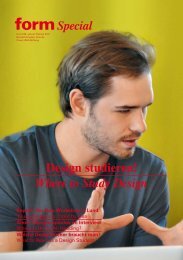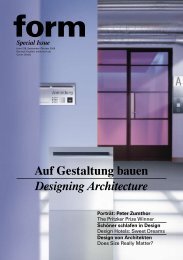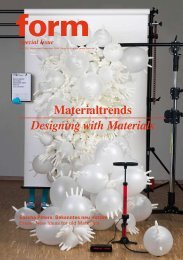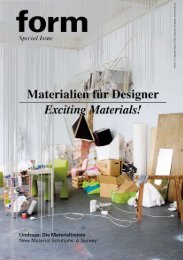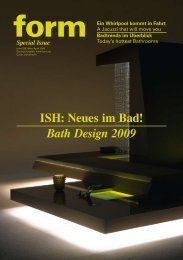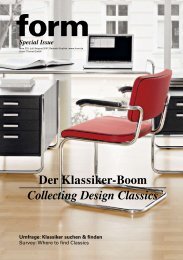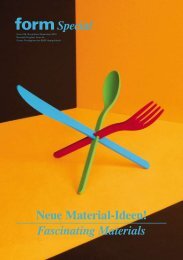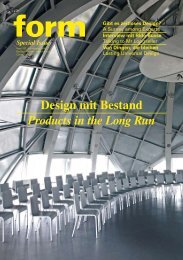Materialien für Designer The Magic of Materials - Creative Industries ...
Materialien für Designer The Magic of Materials - Creative Industries ...
Materialien für Designer The Magic of Materials - Creative Industries ...
Erfolgreiche ePaper selbst erstellen
Machen Sie aus Ihren PDF Publikationen ein blätterbares Flipbook mit unserer einzigartigen Google optimierten e-Paper Software.
16 <strong>Materials</strong><br />
Auf der Messe 100% Design in<br />
London kuratiert Mr. Material<br />
Chris Lefteri jedes Jahr die<br />
Ausstellun g 100% <strong>Materials</strong> –<br />
imme r wieder ein wahres Para -<br />
dies <strong>für</strong> Produktdesigner.<br />
At the 100% Design trade fair in<br />
London, Mr. Material Chris Lefteri<br />
curates the exhibition 100% <strong>Materials</strong><br />
every year – time and again a veritable<br />
paradise for product designers.<br />
material make-up is at the heart <strong>of</strong> addressing this issue.<br />
And a third strand is the exponential growth <strong>of</strong> technologies<br />
today, which is really exciting, and we all know that<br />
especially de signers want to discover and apply this new<br />
and really exciting stuff.<br />
What has been the most relevant development in the<br />
field <strong>of</strong> “new” materials?<br />
Again, it’s not about a single development, more about<br />
many areas <strong>of</strong> research that <strong>of</strong>ten overlap. Bio-mimicry<br />
and nanotechnologies are finding their way into all sorts<br />
<strong>of</strong> materials, not just the well-known textile- and glass<br />
coatings with self-cleaning properties, but also in the<br />
area <strong>of</strong> permanently bonding dissimilar materials. <strong>The</strong>re<br />
is also the area <strong>of</strong> composite materials that has had<br />
huge impact on construction, aerospace and transportation.<br />
One <strong>of</strong> the most interesting new materials in this<br />
category is a ceramic that is based on nacre, the substance<br />
that lines the shells <strong>of</strong> crabs, that combines the<br />
hardness <strong>of</strong> ceramics with the toughness <strong>of</strong> metals. But<br />
there is also less high-tech technology that creates a<br />
new class <strong>of</strong> plastic moulded products that use sawdust<br />
– a by-product <strong>of</strong> the timber industry – and up to 50%<br />
wood fibre. I also think that in the future we will see the<br />
production <strong>of</strong> materials and products become much<br />
more intertwined.<br />
Give me an example, please.<br />
For example in nature, the growth <strong>of</strong> plants and the<br />
productio n <strong>of</strong> material for that growth march in lockstep.<br />
This eliminates the whole man-made process <strong>of</strong> making<br />
a material and then converting it into a final product as<br />
we do with machines, a process that consists <strong>of</strong> many<br />
different steps <strong>of</strong> forming, finishing and transportation.<br />
A lot <strong>of</strong> people believe that what physics and mechanics<br />
was for the 20th century, biological engineering will be<br />
for the 21st century.<br />
In the hands <strong>of</strong> the right people that may hold true. But,<br />
speaking <strong>of</strong> nature, it is obvious that environmentally<br />
safe materials, recyclable materials, have gained a lot <strong>of</strong><br />
attention during the past few years. How can designers<br />
convince a company to use them, even if they are possibly<br />
more expensive?<br />
I think that it is more important that designers get a little<br />
more creative with what constitutes an ecomaterial. I<br />
think we can separate this area into two categories: the<br />
first being those that have some kind <strong>of</strong> “eco” branding<br />
and the second being those that are non-eco labels, but<br />
because <strong>of</strong> their physical properties can reduce weight,<br />
can be processed using little energy or can be easily<br />
recycle d. <strong>The</strong>se are much harder to spot in terms <strong>of</strong> being<br />
“eco” but can be just as, if not more, sustainable<br />
than many so-called “eco materials”.<br />
Do you think in, say, 100 years, many products will look<br />
completely different than they do today because <strong>of</strong> new<br />
materials?<br />
People who try to predict this kind <strong>of</strong> thing always get it<br />
completely wrong, so I have no predictions. <strong>The</strong> next<br />
100 years could potentially result in the concept <strong>of</strong> a<br />
“product” evaporating, and what we mean by a product<br />
being something much less tangible than we have today.<br />
At the moment, our relationship to products and objects<br />
is to a large degree feeding an emotional hunger rather<br />
than facilitating functionality, which, in the main, is what<br />
products were about a 100 years ago. In terms <strong>of</strong> materials<br />
I do think that materials like plastic, wood or metal<br />
will be obsolete, and the only things that will be made<br />
<strong>of</strong> those materials will be antiques from our own century.<br />
A fairly safe prediction would be that these material families<br />
will have evolved to the extent that there will be hybrids<br />
and new biomaterials that are made <strong>of</strong> different<br />
raw ingredients blended together. Also, I always felt that<br />
the future would belong to a single material that could<br />
be tailored to any number <strong>of</strong> applications, a single material<br />
that would take a minimal amount <strong>of</strong> energy to convert<br />
into new products.<br />
www.chrislefteri.com<br />
Der ECKART-Effekt –<br />
ihr Herz- und Wärmerefl ektor.<br />
Innenwandfarben absorbieren durchschnittlich 95% Wärmestrahlung – die Wärme geht komplett über das<br />
Mauerwerk nach außen ab. Transparente Innenwandfarben mit Aluminiumpigmenten können diese Wärme<br />
bis zu 50% in den Raum zurück refl ektieren. Diese technisch weitgehend unkomplizierte Maßnahme reduziert<br />
den Energieverbrauch einer Wohnung und senkt so auch die CO2-Klimabelastung. Das neu entwickelte<br />
wässrige Pigmentkonzentrat SHINEDECOR von ECKART wird einfach transparenten Innenwandfarben zugegeben<br />
– analog dem Einsatz von Abtönfarben. ECKART – take the brilliant way.<br />
ECKART GmbH · Kaiserstrasse 30 · 90763 Fürth · Germany<br />
Tel.: +49 (0)9152-77-0 · Fax: +49 (0)9152-77-7008 · E-Mail: info.eckart@altana.com · www.eckart.net



![[pdf - 2.18 MB] Sonderheft zur ISH - Form](https://img.yumpu.com/11048003/1/184x260/pdf-218-mb-sonderheft-zur-ish-form.jpg?quality=85)
